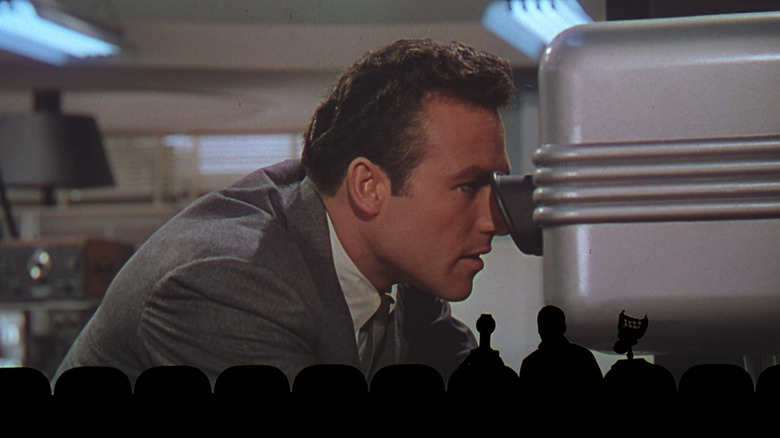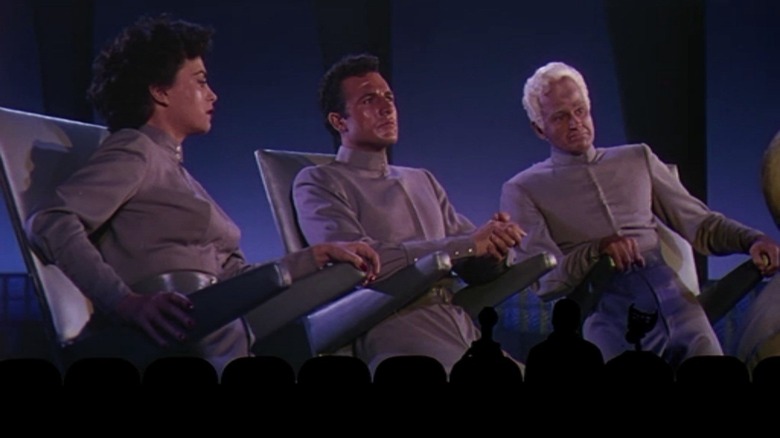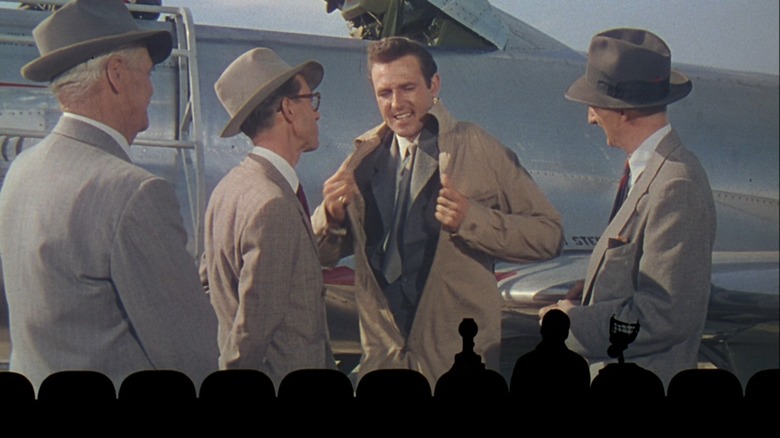Why Joe Dante Took Mystery Science Theater 3000 To Task Over Their Movie
The year is 1995, and "Mystery Science Theater 3000" was undergoing changes. A conflict between producer Jim Mallon and show creator Joel Hodgson — largely over who was running the show and how they should go about making a "Mystery Science Theater 3000" feature film — caused the latter to leave the series halfway through its fifth season (head writer Mike Nelson would take over acting/hosting duties). Additionally, the show's lucrative contract with Comedy Central was about to run out. A man named Doug Herzog was put in control of Comedy Central, and his new vision for the network was raunchy animated programs like "South Park," and the news commentary show "The Daily Show," leaving "MST3K" looking old-fashioned and dried up in comparison.
Because a feature film was already in the early stages of production, producer Mallon, host Nelson, and the rest of the remaining writers decided to give it their all. The filmmakers upped the show's production design (still careful to retain its traditional homemade look), extended the host segments, and included an introductory sequence explaining the premise of the show to audiences. That last detail was required, as the premise of "MST3K" — that is: watching random late-night movies on TV with a retinue of wisecracking, onscreen buddies — may function perfectly well for late night television, but it seems quite unusual for a feature film. Going to a movie theater to watch a movie about other people watching a movie? It's a hard sell.
As such, the filmmakers needed just the right film to "riff" on. Because of the show's sci-fi-evocative title and space-bound setting, the subject of mockery within "Mystery Science Theater 3000: The Movie" had to be a science fiction film. (It would be weird if the feature debut of "MST3K" was a biker movie or a beach party flick.) It also had to be in color, because a black-and-white film, Mallon feared, may put audiences off. And, ironically, the subject had to be watchable in itself, meaning it couldn't be so slow-moving or bad as to repel newcomers. But at the same time, it also had to contain enough awful writing, bad acting, or weird premises as to inspire comedic riffs. Eventually, they settled (wisely one might say) on Joseph M. Newman's and Jack Arnold's 1955 Universal classic "This Island Earth." Color sci-fi classic, imminently watchable, just cheesy enough, weird aliens with big foreheads, a notable movie monster ... it seemed to work perfectly. A lot of these details are iterated in a 2018 oral history published by The AV Club.
Perfectly, that is, until the many, many fans of "This Island Earth" emerged from the woodwork to declare "MST3K" for being unfair to a beloved piece of sci-fi cinema. One of those defenders was "Gremlins" director and longtime fan of 1950s genre films, Joe Dante.
Joe Dante's fandom
Joe Dante's love for 1950s B-pictures cannot be understated. When he's not making a straight-up homage to the one true Great American Showman, William Castle (Dante's film "Matinee" is a fictionized version of Castle's heyday), his films often contain references to some of his favorite sci-fi movies of yore. Recall the scene in "Gremlins" wherein the Time Machine from George Pal's 1960 film adaptation makes an appearance. Or actor Kevin McCarthy reprising his role from 1956's "Invasion of The Body Snatchers" in Dante's "Looney Tunes: Back in Action."
On the special features of the 2013 Blu-ray re-issue of "Mystery Science Theater 3000: The Movie," Dante was interviewed to comment on the show's legacy, and the general history of sci-fi B-movies. In that interview, Dante revealed how annoyed he was that "MST3K" decided to brand "This Island Earth" as a "cheesy movie." The show, after all, was known for riffing on bad movies, not good ones, and "This Island Earth" was a far cry from dregs like "Manos: The Hands of Fate," "Monster A-Go-Go," or "Eegah." Dante wanted to defend "This Island Earth's" quality and reputation, pointing out that it is certainly on par with Pal's 1953 version of "The War of the Worlds."
Additionally, Dante points out, "Mystery Science Theater 3000" didn't give "This Island Earth" a fair shake. The original film is 86 minutes long, and "MST3K: The Movie" was, even with introductions, credits, and host segments, was only 74 minutes in total. Overall, about 30 minutes of the original film were cut, giving any "This Island Earth" neophytes a bad impression of the total movie's tone and pacing.
Some talk about aspect ratios
What's more, "This Island Earth" was notable for its glorious, brightly saturated 1950s Technicolor and then-novel use of a 2.00:1 aspect ratio. The very first CinemaScope (2.39:1 aspect ratio) feature film, "The Robe," was released in 1953, and films began experimenting with screen shapes immediately thereafter. "This Island Earth" was one of the very first films to shoot with an "open matte," which meant they shot a film negative in the old Academy Standard 1.37:1 aspect ratio, and then used a specially designed aperture plate on the projector to correct the image shape. Because many early home video and TV-broadcast editions of movies were haphazard tracked, the 1.37 version was the one most people saw in the years after the film's release.
Dante complained that "MST3K: The Movie" did not retain the film's original color scheme, calling the ultimate version "washed out."
Because "MST3K: The Movie" wanted to present in a 1.85:1 aspect ratio, they — accidentally and perhaps ironically — applied their own matte to the Universal classic, and in so doing restored a closer aspect ratio to "This Island Earth's" intended original. The only difference is there are now silhouettes of the show's characters along the film's bottom edge.
In defense of the cuts and aspect ratio juggling that "MST3K: The Movie" did with "This Island Earth," it may be worth remembering that the washed-out, 1.37 version was the version made most widely available to audiences. What's more, old prints often lost several feet of film throughout the years to bad print handling in projection booths, and TV studios would frequently make cuts to feature films to account for slotted time periods. As such, "MST3K: The Movie" wasn't riffing on the "whole" version of "This Island Earth" as it appeared in theaters, but an unfortunately bowdlerized version more readily available.
As such, "MST3K: The Movie" wasn't necessarily mocking a classic, but pointing out that many films, even big-budget classics, made their way to audiences in versions that made less sense than the original filmmakers intended. It would be like only ever seeing the network TV version of "Pulp Fiction," or a two-hour cut of "The Godfather." There's a classic hiding in there, but you're only getting a piece. As such, "MST3K: The Movie" is just as much criticism as it is comedy.


